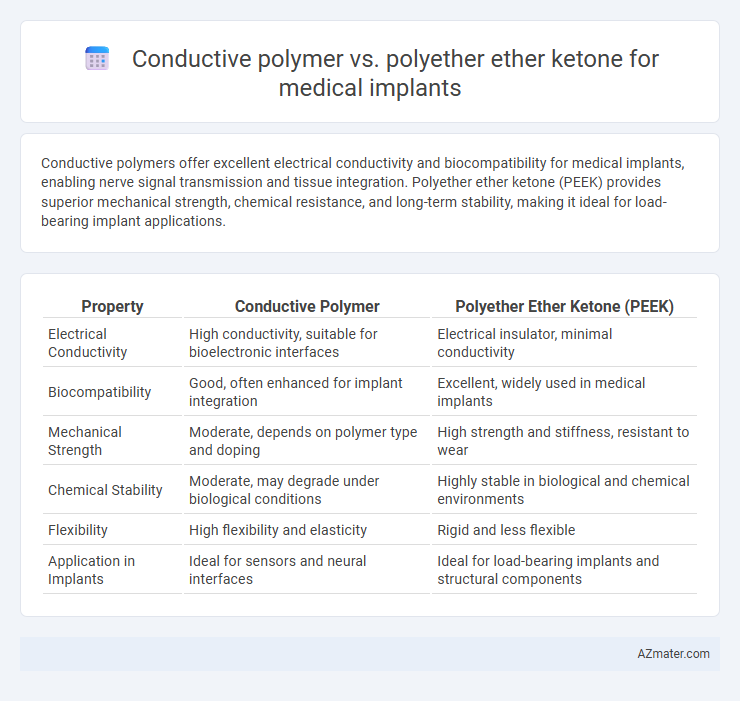Conductive polymers offer excellent electrical conductivity and biocompatibility for medical implants, enabling nerve signal transmission and tissue integration. Polyether ether ketone (PEEK) provides superior mechanical strength, chemical resistance, and long-term stability, making it ideal for load-bearing implant applications.
Table of Comparison
| Property | Conductive Polymer | Polyether Ether Ketone (PEEK) |
|---|---|---|
| Electrical Conductivity | High conductivity, suitable for bioelectronic interfaces | Electrical insulator, minimal conductivity |
| Biocompatibility | Good, often enhanced for implant integration | Excellent, widely used in medical implants |
| Mechanical Strength | Moderate, depends on polymer type and doping | High strength and stiffness, resistant to wear |
| Chemical Stability | Moderate, may degrade under biological conditions | Highly stable in biological and chemical environments |
| Flexibility | High flexibility and elasticity | Rigid and less flexible |
| Application in Implants | Ideal for sensors and neural interfaces | Ideal for load-bearing implants and structural components |
Introduction: Material Choices for Medical Implants
Conductive polymers offer electrical conductivity and flexibility, making them suitable for nerve regeneration and biosensing implants, while polyether ether ketone (PEEK) provides exceptional biocompatibility, mechanical strength, and chemical resistance essential for load-bearing orthopedic implants. The choice between conductive polymers and PEEK depends on the implant's functional requirements, such as electrical stimulation versus structural support. Material selection directly impacts implant performance, longevity, and patient safety in medical applications.
Overview of Conductive Polymers in Biomedical Applications
Conductive polymers, such as polypyrrole and polyaniline, offer unique electrical conductivity and biocompatibility advantages for medical implants, facilitating nerve regeneration and biosensing applications. Unlike Polyether ether ketone (PEEK), which is prized for its mechanical strength and chemical resistance but lacks intrinsic conductivity, conductive polymers enable real-time electrical stimulation and signal transduction in tissue engineering. Their tunable electrical properties and ability to integrate with biological systems make them increasingly valuable in advanced biomedical devices.
Polyether Ether Ketone (PEEK): Properties and Medical Use
Polyether ether ketone (PEEK) exhibits exceptional chemical resistance, biocompatibility, and mechanical strength, making it highly suitable for medical implants such as spinal cages, orthopedic devices, and dental implants. Its radiolucent property allows for clear imaging without interference, facilitating postoperative assessment compared to metallic alternatives. PEEK's thermal stability and low moisture absorption contribute to durable performance in the physiological environment, while its ability to be customized via machining or 3D printing supports patient-specific implant fabrication.
Biocompatibility: Conductive Polymers vs PEEK
Conductive polymers offer enhanced electrical conductivity crucial for neural implants but may present biocompatibility challenges like inflammatory responses and instability in physiological environments. Polyether ether ketone (PEEK) is highly biocompatible, exhibiting excellent chemical resistance, mechanical stability, and minimal tissue reaction, making it widely accepted in orthopedic and spinal implants. While conductive polymers require surface modifications to improve biocompatibility, PEEK remains a gold standard due to its proven long-term success and minimal cytotoxicity.
Mechanical Strength and Durability Comparison
Conductive polymers exhibit moderate mechanical strength and flexibility, making them suitable for applications requiring electrical conductivity and biocompatibility, but their durability under long-term physiological conditions can be limited. Polyether ether ketone (PEEK) offers superior mechanical strength, high wear resistance, and excellent chemical stability, ensuring long-term durability in medical implants subjected to repetitive mechanical stress. The combination of PEEK's robust mechanical properties and resistance to degradation often surpasses conductive polymers in load-bearing implant applications.
Electrical Conductivity: Unique Advantage of Conductive Polymers
Conductive polymers exhibit superior electrical conductivity compared to polyether ether ketone (PEEK), making them ideal for medical implants requiring electrical stimulation or signal transmission. These polymers facilitate enhanced cell signaling and tissue repair through controlled electrical impulses, a functionality that inert PEEK lacks due to its insulating properties. The unique advantage of conductive polymers lies in their ability to integrate electrical functionality with biocompatibility, advancing neuroprosthetics and biosensor technologies.
Sterilization and Chemical Resistance in Implant Environments
Conductive polymers exhibit excellent electrical conductivity and biocompatibility, making them suitable for neural and biosensor medical implants, but their sterilization methods are often limited to low-temperature processes to prevent degradation. Polyether ether ketone (PEEK) offers superior chemical resistance and thermal stability, allowing it to withstand aggressive sterilization techniques like autoclaving, gamma radiation, and ethylene oxide without compromising structural integrity. In implant environments, PEEK's robust resistance to bodily fluids and sterilization agents supports long-term durability compared to conductive polymers, which may degrade under harsh sterilization or chemical exposure.
Surface Modification and Functionalization Techniques
Conductive polymers and polyether ether ketone (PEEK) are widely explored for medical implants due to their biocompatibility and mechanical properties, with surface modification playing a crucial role in enhancing cell adhesion and functionality. Techniques such as plasma treatment, chemical grafting, and layer-by-layer assembly are commonly applied to conductive polymers to improve electrical conductivity and bioactivity, whereas PEEK surfaces benefit from sulfonation, laser treatment, and bioactive coating to enhance hydrophilicity and osteointegration. Functionalization strategies targeting protein immobilization and antimicrobial agent incorporation on both materials significantly advance implant performance by promoting tissue integration and reducing infection risk.
Clinical Performance and Safety Considerations
Conductive polymers exhibit superior electrical conductivity and flexibility, enhancing neural interface applications and reducing foreign body response in medical implants. Polyether ether ketone (PEEK) offers exceptional biocompatibility, mechanical strength, and chemical resistance, making it ideal for load-bearing implants like spinal cages and orthopedic devices. Clinical performance of conductive polymers is promising in neuroprosthetics with ongoing biocompatibility improvements, while PEEK remains a gold standard for long-term implant safety due to its stability and low inflammatory potential.
Future Perspectives: Innovations in Medical Implant Materials
Conductive polymers offer promising advancements in medical implants with their inherent electrical conductivity and flexibility, enabling enhanced neural interfacing and real-time biosensing capabilities. Polyether ether ketone (PEEK) remains a leading material due to its exceptional biocompatibility, chemical resistance, and mechanical strength, particularly in load-bearing orthopedic applications. Future innovations focus on hybrid composites combining conductive polymers with PEEK to achieve multifunctional implants that improve tissue integration, enable smart monitoring, and promote personalized medical treatments.

Infographic: Conductive polymer vs Polyether ether ketone for Medical implant
 azmater.com
azmater.com